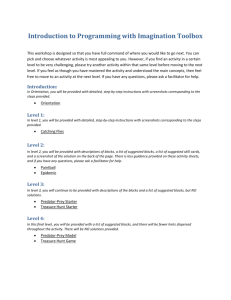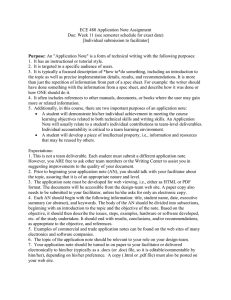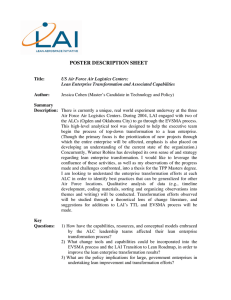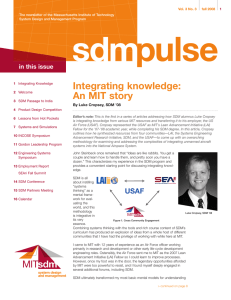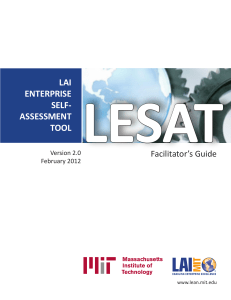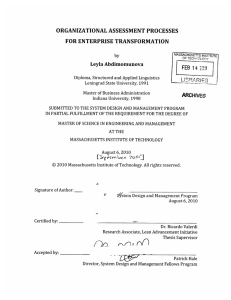Document 10674787
advertisement
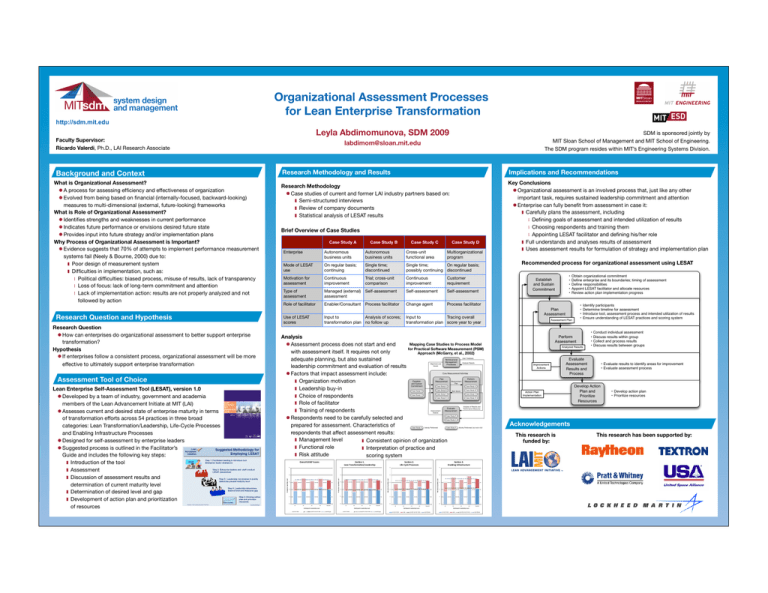
Organizational Assessment Processes ! for Lean Enterprise Transformation http://sdm.mit.edu Leyla Abdimomunova, SDM 2009! Faculty Supervisor: Ricardo Valerdi, Ph.D., LAI Research Associate Case Study B Case Study C Case Study D Autonomous business units Autonomous business units Cross-unit functional area Multiorganizational program Mode of LESAT use On regular basis; continuing Single time; discontinued Single time; On regular basis; possibly continuing discontinued Motivation for assessment Continuous improvement Trial; cross-unit comparison Continuous improvement Customer requirement Type of assessment Managed (external) assessment Self-assessment Self-assessment Self-assessment Role of facilitator Enabler/Consultant Process facilitator Change agent Process facilitator Use of LESAT scores Input to Analysis of scores; transformation plan no follow up Input to Tracing overall transformation plan score year to year Analysis Mapping Case Studies to Process Model Assessment process does not start and end for Practical Software Measurement (PSM) with assessment itself. It requires not only Approach (McGarry, et al., 2002) adequate planning, but also sustained leadership commitment and evaluation of results Factors that impact assessment include: Organization motivation Leadership buy-in Choice of respondents Role of facilitator Training of respondents Respondents need to be carefully selected and prepared for assessment. Characteristics of respondents that affect assessment results: Management level Consistent opinion of organization Functional role Interpretation of practice and Risk attitude scoring system 8.%$;(,<=,, -."(,:#"(+>;#?"$;(@-."/.#+0&', 71.#"22,-389:,8%;#.+, 8.%$;(,A=,, -&>.,46%2.,!#;%.++.+, 8.%$;(,B=,, 3("52&(C,D(>#"+)#E%)E#., .# .# .# .# &# &# &# &# %# $# %# $# "# "# !"# !$# !%# !&# '()*+,,# 4+5# 6()*+,,#/0**)12#32+2)# $# !$# !%# !&# '()*+,,# /0**)12#32+2)# 4+5# 6()*+,,#/0**)12#32+2)# $# -# !"# !"#$%&'"()*+,-."/.#+0&',-.1.2, 6()*+,,#4+5# %# "# -# !"# !"#$%&'"()*+,-."/.#+0&',-.1.2, /0**)12#32+2)# %# "# -# -# 3().#'#&+.,4"'"5&2&)6,-.1.2, Assessment Tool of Choice Lean Enterprise Self-Assessment Tool (LESAT), version 1.0 Developed by a team of industry, government and academia " members of the Lean Advancement Initiate at MIT (LAI) Assesses current and desired state of enterprise maturity in terms" of transformation efforts across 54 practices in three broad " categories: Lean Transformation/Leadership, Life-Cycle Processes " and Enabling Infrastructure Processes Designed for self-assessment by enterprise leaders Suggested process is outlined in the Facilitator’s" Guide and includes the following key steps: Introduction of the tool Assessment Discussion of assessment results and " determination of current maturity level Determination of desired level and gap Development of action plan and prioritization" of resources Case Study A Enterprise 3().#'#&+.,4"'"5&2&)6,-.1.2, Research Question How can enterprises do organizational assessment to better support enterprise transformation? Hypothesis If enterprises follow a consistent process, organizational assessment will be more effective to ultimately support enterprise transformation Implications and Recommendations Brief Overview of Case Studies 3().#'#&+.,4"'"5&2&)6,-.1.2, Research Question and Hypothesis Research Methodology and Results Research Methodology Case studies of current and former LAI industry partners based on: Semi-structured interviews Review of company documents Statistical analysis of LESAT results 3().#'#&+.,4"'"5&2&)6,-.1.2, Background and Context What is Organizational Assessment? A process for assessing efficiency and effectiveness of organization Evolved from being based on financial (internally-focused, backward-looking) measures to multi-dimensional (external, future-looking) frameworks What is Role of Organizational Assessment? Identifies strengths and weaknesses in current performance Indicates future performance or envisions desired future state Provides input into future strategy and/or implementation plans Why Process of Organizational Assessment is Important? Evidence suggests that 70% of attempts to implement performance measurement systems fail (Neely & Bourne, 2000) due to: Poor design of measurement system Difficulties in implementation, such as: Political difficulties: biased process, misuse of results, lack of transparency Loss of focus: lack of long-term commitment and attention Lack of implementation action: results are not properly analyzed and not followed by action SDM is sponsored jointly by MIT Sloan School of Management and MIT School of Engineering. The SDM program resides within MIT’s Engineering Systems Division. labdimom@sloan.mit.edu !$# !%# !&# '()*+,,# !"# 6()*+,,#4+5# /0**)12#32+2)# !"#$%&'"()*+,-."/.#+0&',-.1.2, 6()*+,,#4+5# /0**)12#32+2)# 4+5# 6()*+,,#/0**)12#32+2)# !$# !%# !&# '()*+,,# !"#$%&'"()*+,-."/.#+0&',-.1.2, 4+5# 6()*+,,#/0**)12#32+2)# 6()*+,,#4+5# Key Conclusions Organizational assessment is an involved process that, just like any other important task, requires sustained leadership commitment and attention Enterprise can fully benefit from assessment in case it: Carefully plans the assessment, including Defining goals of assessment and intended utilization of results Choosing respondents and training them Appointing LESAT facilitator and defining his/her role Full understands and analyses results of assessment Uses assessment results for formulation of strategy and implementation plan Recommended process for organizational assessment using LESAT • • • • • Establish and Sustain Commitment Obtain organizational commitment Define enterprise and its boundaries; timing of assessment Define responsibilities Appoint LESAT facilitator and allocate resources Review action plan implementation progress • • • • Plan Assessment Assessment Plan Identify participants Determine timeline for assessment Introduce tool, assessment process and intended utilization of results Ensure understanding of LESAT practices and scoring system Perform Assessment Analyzed Results Improvement Actions • • • • Conduct individual assessment Discuss results within group Collect and process results Discuss results between groups Evaluate Assessment Results and Process Action Plan Implementation • Evaluate results to identify areas for improvement • Evaluate assessment process Develop Action Plan and Prioritize Resources • Develop action plan • Prioritize resources Acknowledgements This research is funded by: This research has been supported by:
